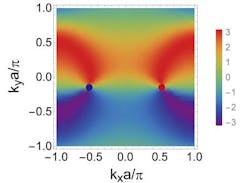'Weyl semimetal' shows larger nonlinear optical response than any other known crystal
Scientists at the University of California, Berkeley and Lawrence Berkeley National Laboratory (also in Berkeley) have experimentally discovered that a so-called Weyl semimetal, tantalum arsenide (TaAs), has the largest nonlinear optical response of any known crystal, achieving second-harmonic generation (SHG) of light with unprecedented response.1
Specifically, the value of the second-order nonlinear optical polarizability χ(2) in TaAs is larger by about a factor of ten than its value in the conventional electro-optic materials gallium arsenide (GaAs) and zinc telluride (ZnTe).
This study is already stimulating the development of fundamentally new theories about these responses, according to the researchers. Nonlinear optical materials are useful in package-penetrating sensors, night vision goggles, and other devices.
Weyl semimetals
Weyl fermions are novel particles that were predicted to be seen in high-energy physics experiments but have not been observed. However, scientists recently observed these particles as an emergent property of electrons in a unique set of semimetal materials. Recent studies have shown that Weyl semimetals exhibit an unexpectedly large nonlinear optical response. This response gives rise to the largest optical second harmonic generation effect of any known crystal. These observations were made in the transition metal systems tantalum arsenide (TaAs), tantalum phosphide (TaP), and niobium arsenide (NbAs).
Although it was clear from symmetry considerations that there would be a nonlinear response in these systems, there was no theoretical prediction suggesting the large magnitude of response observed. By comparison with other well-known nonlinear crystals, the nonlinear optical response in these systems is larger by factors of 10 to 100. Given the unexpected response, scientists anticipate these findings will stimulate the development of advanced ab initio methods to calculate nonlinear-optical-response functions in these materials. Also, Weyl semimetals are expected to have a wide range of optoelectronic applications as materials to be used for the development of terahertz generators and far-infrared radiation detectors.
Source: https://science.energy.gov/bes/highlights/2018/bes-2018-03-b/
REFERENCE:
1. Liang Wu et al., Nature Physics (2017); doi: 10.1038/nphys3969.

John Wallace | Senior Technical Editor (1998-2022)
John Wallace was with Laser Focus World for nearly 25 years, retiring in late June 2022. He obtained a bachelor's degree in mechanical engineering and physics at Rutgers University and a master's in optical engineering at the University of Rochester. Before becoming an editor, John worked as an engineer at RCA, Exxon, Eastman Kodak, and GCA Corporation.
